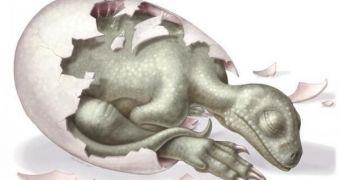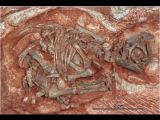After over 30 years of sitting in collections, a few extremely well-preserved dinosaur eggs containing the oldest embryos of any land-dwelling vertebrate ever found, gave new insight into the development and growth of early dinosaurs.
They were found in 1976 in South Africa, and they are 190 million years old, dating from the early Jurassic Period.
They are known to belong to Massospondylus, a member of a group of dinosaurs called prosauropods – the ancestors of the later sauropods (the large, four-legged dinosaurs with long necks, like the more popular ‘Brontosaurus’ and Diplodocus).
Inside the eggs, there were the oldest known embryos of dinosaurs, or of any land-dwelling backboned animal, for that matter.
The embryos were perfectly preserved, which allowed the skeleton and the entire anatomy to be completely reconstructed, and judging by the level of ossification, these embryos were not far from hatching.
According to the fossils, the future hatchlings would have been oddly proportioned, looking very different from their parents.
The embryos measured 20 cm (8 inches), walked on four legs and had long forelimbs and disproportionately large heads.
They did not look much like the adults, which were 5 m (16.5 feet) long and had relatively small heads and long necks.
They were also mostly likely bipedal, with their forelimbs much shorter than their hind limbs, according to The Society of Vertebrate Paleontology.
This means that as the dinosaurs grew up, their necks and hind limbs grew much faster than their forelimbs and head, however, the sauropods had body proportions more similar to the Massospondylus embryos'.
Dr. Robert Reisz of the University of Toronto and his colleagues worked on these fossils, and they said that they were able to find out these information thanks to modern preparation techniques.
Massospondylus had an infancy very similar to that of humans, as they were able to stand only as they grew, and their bodies were not evenly proportioned from the beginning.
Also, the embryos had no teeth, so this means that they must have needed their parents around for a while, making this discovery the oldest evidence of parental care.
Reisz said that “this project opens an exciting window into the early history and evolution of dinosaurs.
“Prosauropods are the first dinosaurs to diversify extensively, and they quickly became the most widely spread group, so their biology is particularly interesting as they represent in many ways the dawn of the age of dinosaurs.”
The exhibit containing the eggs and embryos is entitled “Dinosaur Eggs and Babies: Remarkable Fossils from South Africa”, and is on display at the Royal Ontario Museum.

 14 DAY TRIAL //
14 DAY TRIAL // 
